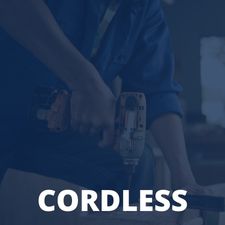The Best Corded and Cordless Hammer Drills in Australia — Information, Buyers Guides, Comparisons, and Reviews
Powering into dense masonry, concrete, and cement with a traditional drill can be challenging — corded and cordless hammer drills are the tools for the job. Like normal boring machines, they deliver a typical rotary bit movement — but unlike their everyday counterparts, also include an impact function.
This permits the machines to bore as well as pound, weakening your target medium and enabling effortless penetration into the stubbornest materials. And, for softer mediums such as wood and plastic, you can turn off the hammer mode and use a more refined drilling approach.
- What Are Corded and Cordless Hammer Drills?
- Hammer Drill Transmissions
- Hammer Drill Chucks
- Cordless Hammer Drills vs Corded vs Rotary
- Hammer Drill Operating Tips
- How To Choose the Best Hammer Drill
- Hammer Drill Accessories
- Our Top Picks of the Ultimate Corded and Battery-Powered Hammer Drills
- Hammer Drills Conclusion
- Hammer Drills FAQs
Hammer Drill Product Comparison Table
| IMAGE | PRODUCT | DETAILS | ||
|---|---|---|---|---|
|
Best Cordless Hammer Drill 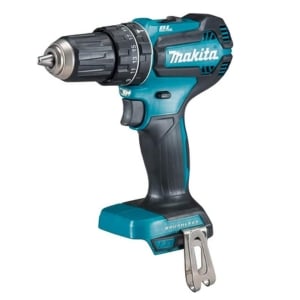
|
Best Cordless Hammer Drill
|
Makita DHP485Z
|
Features
|
Check Price at Amazon Check Price at Toolmart Makita DHP485Z Review Makita DHP485Z Review |
|
Best Compact Hammer Drill 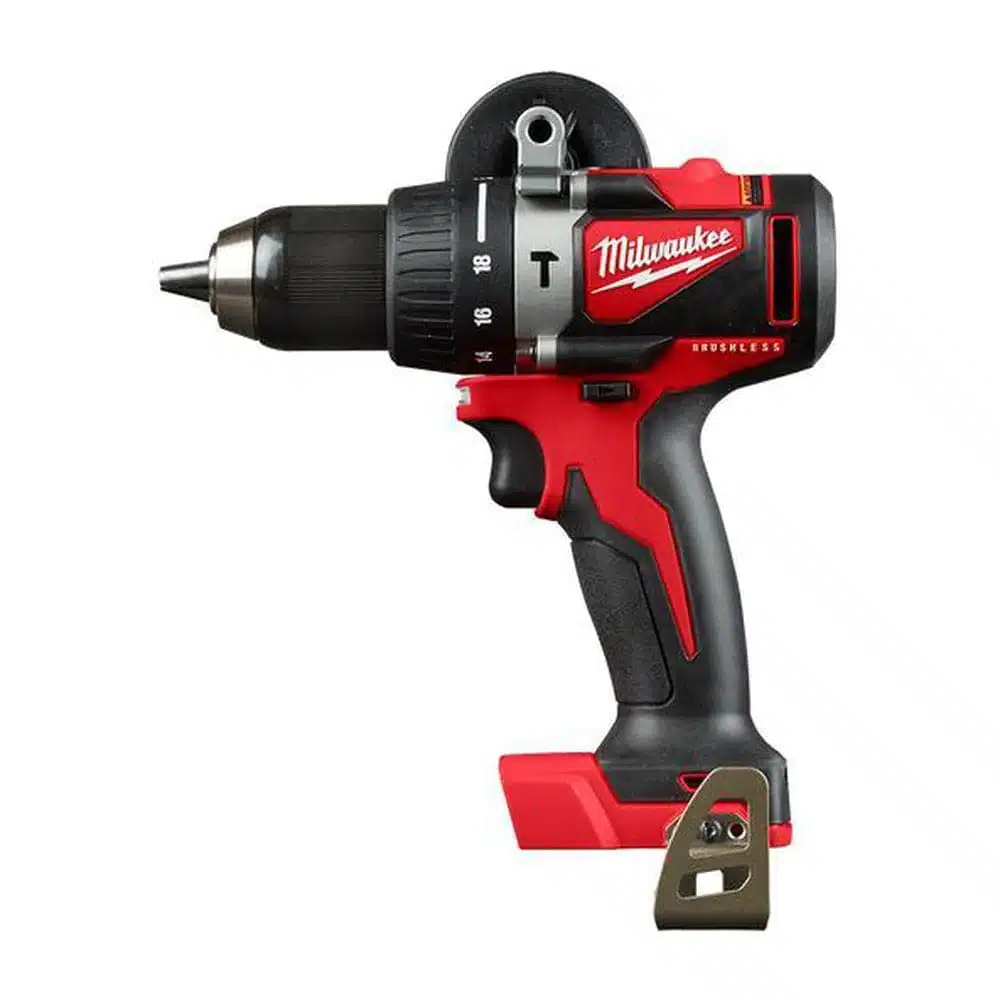
|
Best Compact Hammer Drill
|
Milwaukee M18BLPD2-0
|
Features
|
Check Price at Tools Milwaukee M18BLPD2-0 Review Milwaukee M18BLPD2-0 Review |
|
Best Cordless Hammer Drill for Torque 
|
Best Cordless Hammer Drill for Torque
|
HiKOKI DV18DBL2
|
Features
|
Check Price at Toolmart HiKOKI DV18DBL2 Review HiKOKI DV18DBL2 Review |
|
Best Cordless High Impact Hammer Drill 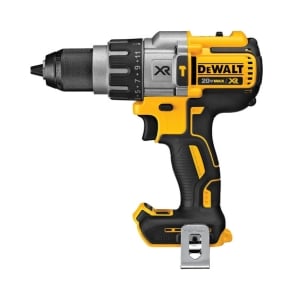
|
Best Cordless High Impact Hammer Drill
|
DeWalt DCD996B
|
Features
|
Check Price at Amazon Check Price at Toolmart DeWalt DCD996B Review DeWalt DCD996B Review |
|
Best Cordless Complete Kit Hammer Drill 
|
Best Cordless Complete Kit Hammer Drill
|
Bosch Universal Impact 18V-60
|
Features
|
Check Price at Amazon Bosch Universal Impact 18V-60 Review Bosch Universal Impact 18V-60 Review |
|
Best Cordless Impact Driver and Hammer Drill Combo

|
Best Cordless Impact Driver and Hammer Drill
Combo
|
Metabo AU68902480
|
Features
|
Check Price at Tools Metabo AU6890248 Review Metabo AU6890248 Review |
|
Best Cordless Impact Driver and Hammer Drill Combo
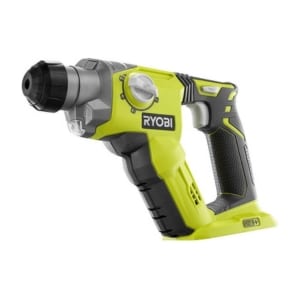
|
Best Cordless Impact Driver and Hammer Drill
Combo
|
Ryobi P222 One+
|
Features
|
Check Price at Amazon Ryobi P222 One+ Review Ryobi P222 One+ Review |
|
Best Affordable Corded Hammer Drill 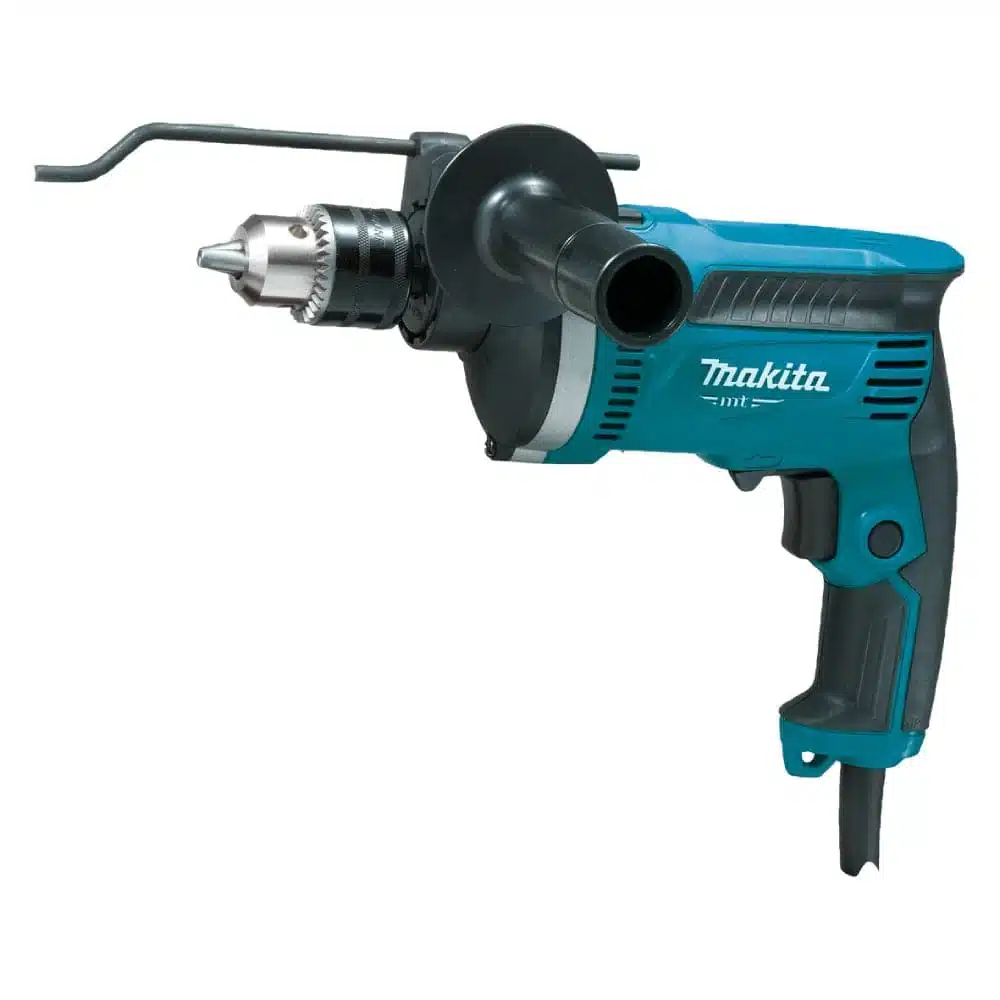
|
Best Affordable Corded Hammer Drill
|
Makita M8100KB
|
Features
|
Check Price at Toolmart Makita M8100KB Review Makita M8100KB Review |
|
Best Tradie/Professional Corded Hammer Drill 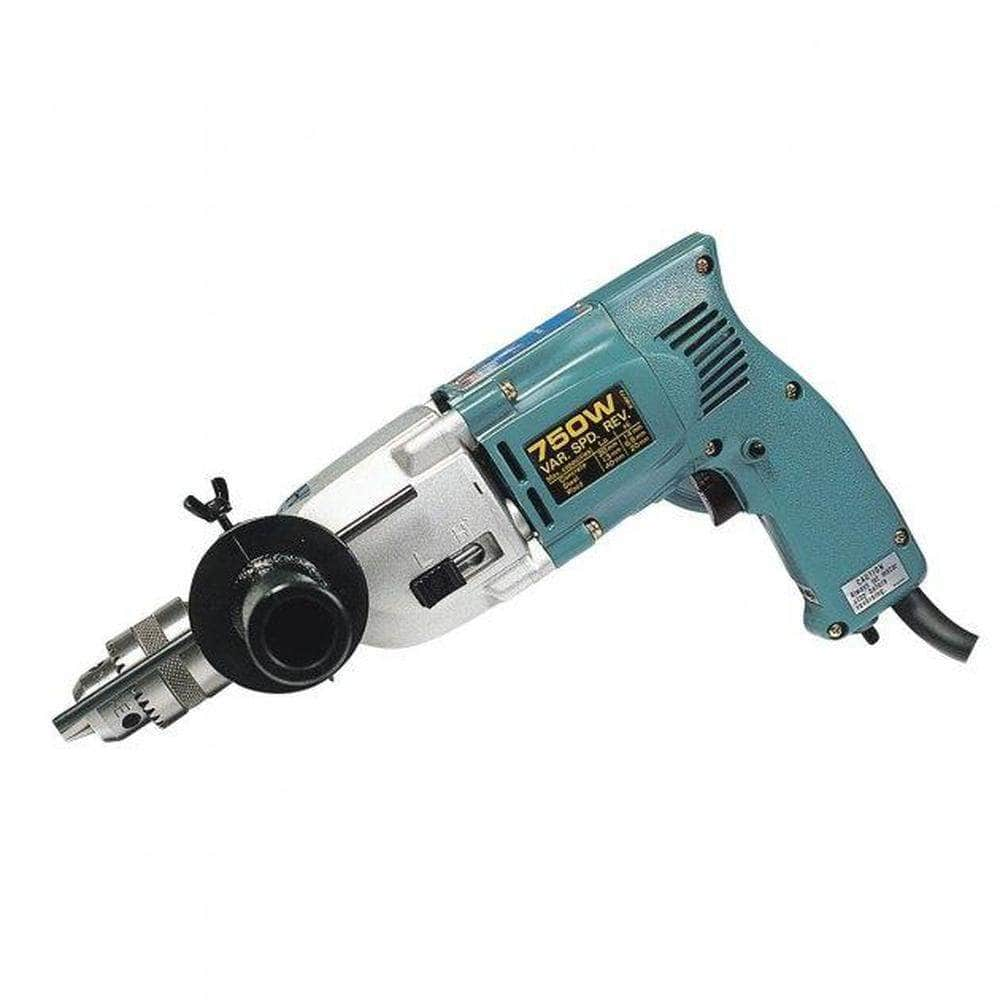
|
Best Tradie/Professional Corded Hammer Drill
|
Makita HP2010N
|
Features
|
Check Price at Toolmart Makita HP2010N Review Makita HP2010N Review |
What Are Corded and Cordless Hammer Drills?
Corded and cordless hammer drills — also known as impact drills or percussion drills — are incredibly versatile tools capable of performing many trying tasks. These projects include penetrating masonry — which comprises materials such as bricks and concrete.
Hammer drills are also extremely adept at boring various-sized holes through metal, wood and plastics.
The hammer function is the setting used on these machines to power through masonry — it enables the drill to produce rapid bit impacts that chip away at dense concrete and brickwork while the chuck continues to rotate.
Internally, the hammer action is produced by two metal plates connected to the drill’s drive shaft with opposing raised edges. These plates connect when pressure is applied to the chuck, and as the chuck rotates, these plates rapidly move the drive shaft back and forth.
Therefore, the faster the drill rotates, the more rapid the hammer action becomes — making it less challenging to drive through masonry. The rating on these machines to indicate the maximum speed of this pounding feature is blows per minute (BPM) or impacts per minute (IPM).
When choosing your hammer drill, consider:
-
- Format — electric corded or battery-powered.
- Lock-on feature.
- Forward/reverse.
- Drilling mode.
- Chuck.
- Side handle.
- Depth gauge.
- Motor.
- Speed and impact.
Hammer Drill Transmissions
Also known as the gearbox, hammer drill transmissions dictate the speed range (revolutions per minute, or RPM) the drill operates at, and the corresponding torque (or turning force) it produces.
Hammer drills can be broken up into two main categories — hammer drills with a single gear, and those with two gears.
Single-Speed Hammer Drills
These hammer drills have only one gear and are the most affordable machines. Usually, they weigh between 1.5 and 2 kg.
Typically, they can reach maximum speeds of about 3,000 RPM — very similar to a standard drill. The rapidity is dictated by a variable speed trigger, and allows the drill to perform a multitude of tasks. When the drill is switched to hammer mode, these drills typically produce about 30000 BPM.
On average, single-speed hammer drills can drill a 15 mm hole into masonry, a 13 mm hole through metal, and a 30 mm hole into wood.
These maximum drilling sizes depend on the particular model of the drill, and I suggest that you consult these specifics before making a purchase.
Two-Speed Hammer Drills
These drills are titled two or twin-speed because of their dual transmissions. This style of gearbox gives these units user tailorability advantages over their single-speed counterparts. Two-speed hammer drills can be distinguished by a numbered gear switch or dial located on the top or side of the tool.
In first gear — much like a car — these drills turn at a slow speed but produce a very high amount of torque (the turning force). This brawn, combined with the hammer drill’s powerful motor, enables them to perform tough material penetration.
When you select second gear, the RPM picks up, but the torque is reduced. This is a perfect setting for making smaller holes in wood, and metal. For average-size masonry holes, this is also the ideal setting, as blows per minute (BPM) are increased dramatically in this mode. The varying speeds for each gear are dictated by how far you depress the variable speed trigger.
Capacities vary amongst different models, but the best hammer drills with two speeds should be able to drill a 20 mm hole into masonry, a 15 mm hole in metal, and 40 mm into wood.
The more powerful models of hammer drills may also come with torque limiters or clutches. This reduces potential damage to the user and the drill if the drill bit jams during use.
These maximum drilling sizes depend on the particle model of the drill, and I recommend that you consult these specifics before making a purchase.
Hammer Drill Chucks
The chuck is the part of the drill that grips drilling bits or accessories. The transmission powers the drive shaft, and on the end of this shaft is the chuck. On hammer drills, there are three types — keyed, keyless, and SDS (slotted drive shaft).
Keyed Chucks
These chucks have a solid metal construction, which makes them very durable through excessive vibrations and dust, and are operated by a chuck key. When fitted, the key fits into the gear notches of the chuck. And, as you turn, it either loosens or tightens depending on the turning direction.
Keyless Chucks
Faster to tighten than keyed, and operated completely by hand — keyless chucks save you the hassle of hunting around for your key. Depending on the quality and purpose of the drill, these chucks can be plastic or metal, or a combination of the two, and usually have a front and rear sleeve.
To loosen/tighten the chuck manually, place one hand on the rear sleeve of the chuck and turn the front sleeve right/left. To do this with the aid of the drill, hold the front sleeve of the chuck while you apply some reverse/forward acceleration to the drill.
SDS Chucks
Featuring distinctive ‘wings’ on the site of their bits, SDS delivers the greatest bit stability in all the chuck categories. Utilising a trademarked push-and-lock system, they can withstand hardcore torque, speed, and high impact rates.
This makes SDS chucks perfect for hammer drills — especially when addressing stubborn materials such as masonry. Typically, they’re a standard feature on premium rotary hammer drill units.
Cordless Hammer Drills vs Corded vs Rotary
Cordless Hammer Drill
As the name suggests, these machines offer the freedom from cord tethering and are powered by a powerful lithium-ion cell.
While still providing both drill and hammer capabilities offered by their corded cousins, they typically lack the exceptional grunt and torque of the mains-driven machines. Furthermore, once your battery is depleted, drilling has to stop — unless you have backup cells.
However, cordless units offer greater portability, allow for use away from power sockets, and eliminate the risks of trips and snags caused by electric cables.
Corded Hammer Drill
The original pounding machine format, corded hammer drills deliver greater power consistency, output, and length of operation than cordless — since they don’t require recharging.
Generally lighter on your wallet than the battery-powered models, they’re usable straight-out-of-the-box — whereas many cordless machines require a separate lithium-cell purchase and charging of the battery before work can begin.
However, despite their grunt, they cannot match the immense power of rotary drills.
Rotary Hammer Drill
Driven by an internal piston instead of a standard clutch, rotary hammer drills are the brawniest machines in the hammer tool arena.
Available in both corded and cordless formats, they knock out more torque-pounding power than standard hammer drills. However, this immense strength is compromised in speed and impact per minute.
In virtually all units, rotary hammer drills boast an SDS chuck — required to keep the bit secure under high pressure. Furthermore, they also include twin handles — necessary to wield these behemoths.
The downside is, that you can’t disengage the hammering feature — meaning they’re useless for all materials except masonry.
Hammer Drill Operating Tips
The following tips will help to preserve the life of your hammer drill, increase your efficiency, and most importantly, keep you safe:
- Personal protective equipment (PPE) must always be worn when operating power tools. Here is more information on power tool PPE and safety.
- Use the correct bit for the material type and density.
- Create a pilot hole first — this prevents slippage and reduces the risk of your material splitting or cracking.
- Use steady pressure — hold the hammer drill with two hands and apply firm, yet consistent, pressure.
- Remember to select hammer or drill mode — only use the hammer setting when driving into masonry and brickwork.
- Keep the drill bit at right angles to your target material.
- Practice, practice, practice — if you’re a drilling newbie or have purchased a new machine, first gain some experience with some waste material.
In all circumstances, read the manufacturer’s instructions and precautions before using your tool.
How To Choose the Best Hammer Drill
The best cordless hammer drill or corded machine can only be considered the optimum machine if it meets your preferences and the demands of your projects. What may be crucial features for one user may be unnecessary for another.
Here are a few considerations you should think about when selecting your ideal unit:
Format
Decide whether you need the immense grunt of a rotary drill, or if you find a standard hammer drill sufficient. Bear in mind that rotaries are only suitable for masonry, while a general hammer drill can also tackle metal, plastic, and timber.
And, whichever type you opt for — think about whether you want the operational freedom of a cordless drill, or the power reliability of a corded unit.
Lock-On Button
Machines with this feature allow you to press a lock-on button while the trigger is depressed. It means you can then release the trigger while the tool continues to drill. This saves digit fatigue.
Make sure you release this button before disconnecting the tool. If not, the tool will begin to operate upon reconnection and may result in injury. Here are more safety recommendations.
Forward/Reverse Switch
With a flick of a switch, the drilling direction changes to allow for forward and reverse motion. This can be very helpful if you need to remove screws, or if you need to release your drill bit after it has jammed in a hole.
If flicked between forward and reverse in a neutral position, it also locks the switch to prevent accidental operation of the tool.
You should never change the direction of drive whilst the tool is still operating, as it’s highly likely you will damage the tool’s gears.
Drilling Mode
On hammer drills, the mode switch allows you to choose between normal drilling and hammer drilling (for masonry). These symbols are illustrated and described below.
Drilling:
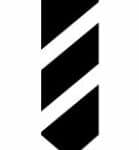
This mode allows for powerful standard drilling and screw driving.
Hammer Drilling:
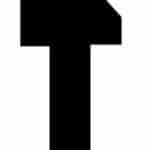
This mode engages a hammer drill’s hammer action combined with drilling. Some models include an impact-only setting — sometimes known as chiselling mode — where the bit pounds but doesn’t rotate, used specifically for demolition work.
Chuck
Think about whether you need an SDS, keyed, or keyless chuck.
SDS chucks offer the most stability — crucial if the majority of your projects require addressing stubborn masonry. Keyed chucks also offer reassuring bit security, but you can’t replace bits if you misplace the key. Keyless machines are the most user-friendly, yet they lack the gripping ability to power into seriously dense concrete.
Transmission
Consider whether you need a single or dual-speed machine. Single transmissions are lighter on your pocket than a twin, but they lack the versatility to crank up or down the power to best suit your target medium.
Motor
Hammer drills include two different motor formats — brushed and brushless.
Brushless motors cut back on friction and heat, increasing the efficiency of the machine. For cordless drills, this leads to longer running times from a single charge.
Brushed motors are cheaper to manufacture, and lead to a more affordable drill. However, they will rapidly drain the battery of cordless machines, require more maintenance, and may overheat during extended use.
Handles
The main handle is the component of the drill that you hold with your dominant hand — and what you use to apply pressure to the drill.
On most hammer drills, the handle is in pistol-grip format — toward the top of the handle. On some of the best units, there will be a finger mould for your thumb and index finger for additional comfort and balance.
Some units include a removable and rotatable side handle to elevate stability. It’s secured just behind the chuck and can be positioned at various angles to allow you to drill at awkward angles.
Speed and Impact
The impact rate — referred to by manufacturers as blows per minute (BPM) or impacts per minute (IPM) — describes how many times the drill bit pounds masonry every sixty seconds. Generally speaking, the higher the BPM, the faster you will power through concrete.
That’s not the case, however, for rotary drills.
Since they deliver such massive grunt with each blow, they don’t need such a high rate of impact as their standard hammer cousins. This is worth considering when making a purchase, as a lower BPM-rated rotary often isn’t less powerful than a high-BPM normal hammer unit.
Furthermore, consider the rotational speed of the tool, measured in RPM. Usually, the faster the tool — the more rapidly you can drill and drive into timber, plastics, and metals.
This is crucial when choosing your optimum masonry drill, as you need to ensure you’re comparing like-with-like. Hence, a rotary machine knocking out 4400 BPM should provide the same brick-crushing enjoyment as a corded unit delivering 44000 BPM.
Hammer Drill Accessories
For a comprehensive guide to the best hammer drill accessories, please see our separate drilling accessories section.
Our Top Picks of the Ultimate Corded and Battery Powered Hammer Drills
Finding the ideal hammer drill to suit your preferences and the demands of your projects can be challenging in a flooded market.
To save you time and confusion, I’ve put together my ultimate picks of the best machines currently available — with a tool for every level of experience and job type.
Makita DHP485Z

With its affordable price point, impressive speed and brawn, and built by a respected manufacturer — the cordless DHP485Z Makita hammer drill is my top-pick battery-powered hammer drill. It knocks out a welcome 1900 RPM, while providing a steady 28500 BPM — making it as suited to the light contractor as the serious DIYer.
Twin LED lamps provide welcome illumination to your target drilling or driving area, while dual-speed permits impressive user control. It also boasts bespoke XPT tech that guards against moisture and detritus ingress — elongating tool life. Furthermore, it delivers a brawny 50 Nm of torque to address stubborn materials.
Pros
Standard 0.5-inch/13 mm chuck.
Robust metal gear transmission build.
Makita brushless hammer drill.
Makita brushless hammer drill.
21 torque settings.
Cons
Doesn’t include a battery or charger.
Reserved BPM may be insufficient for stubborn masonry.
Milwaukee M18BLPD2-0

Compact, yet still delivering 28800 BPM and 1800 RPM — the cordless M18BLPD2-0 Milwaukee hammer drill could be the ultimate confined space cordless hammer drill. Measuring just 180 mm in length, it can access tight and awkward spaces while driving its 0.5-inch/13mm chuck. And, with a brushless motor, it promises heightened battery life and durability.
Trademarked REDLINK tech protects lithium-cell lifespan, while 18 clutch settings permit you to select the ideal amount of torque for your project. The tool arrives with a handy belt clip and removable side handle — and weighs just 1.8 kg. Despite its small size, this machine can still knock out a grunty 82 Nm of torque.
Pros
Ideal for overhead work.
All-metal gear casing.
Twin-speed settings.
Lengthy five-year warranty.
USA-based manufacturer.
Cons
Lacks torque for seriously dense mediums.
Tool-only — requires separate purchase of cell and charger.
HiKOKI DV18DBL2

Pushing out an immense 136 Nm of torque — the DV18DBL2 from HiKOKI is an ideal cordless hammer drill for serious DIYers and pros frequently tackling dense and stubborn materials. Adjustable through 22 different torque clutch settings — you can tailor the unit to perfectly address your medium, and prevent splitting on softer materials.
Its generous and lengthy side handle permits greater leverage to plough into masonry, while its rapid 2100 RPM and mighty 31500 BPM make light work of concrete, metals, and timber. Although somewhat weighty at 2.5 kg, its brushless motor promises long battery life — and its rubberised pistol grip offers reassuring stability in your hand.
Pros
Most powerful torque and speed in its class.
Optimum gear ratios.
Up to 220 holes from a single charge.
Easy-rotatable clutch dial.
Compact build.
Cons
18-volt cell and charger not included.
Secondary side-handle is liable to slip.
DeWalt DCD996B

With a massive 38250 BPM, the cordless DCD996B DeWalt hammer drill delivers rapid blows for a cordless hammer drill — making it ideal for DIYers and tradies who frequently deal with masonry. An inbuilt-LED spotlight ensures sufficient illumination in poorly lit areas, while 11 clutch settings permit you to knock out the most suitable grunt for your target material.
Its ergonomic and textured handle ensures grip stability — and three speed settings enable welcome user control. The DeWalt cordless hammer drill boasts a 0.5-inch/13mm nitro-carburised metal keyless chuck that promises a reassuring grip and impressive durability. What’s more, with an incorporated belt hook, it offers effortless storage when you’re on ladders or scaffolding.
Pros
Brushless motor.
Includes side handle.
Made in America.
High impact and speed.
Three-mode lamp.
Cons
Requires 20-volt cell — not included.
Little rear ventilation — could overheat.
Bosch Universal Impact 18V-60

Including everything you need to crack on with drilling immediately after unboxing — the Impact 18V-60 from Bosch is a complete cordless hammer drill kit for the DIYer. The set includes a hard storage case, 18-volt lithium cell, and a charger — and a drill that knocks out 1900 RPM and 28500 BPM from its energy-efficient brushless motor.
Twin gears and 20 clutch settings allow you to set the perfect speed and torque for your current projects — while trademarked Syneon tech protects battery health, extending operational time per charge. With 60 Nm of torque, the tool is sufficient for most home improvement projects — although underpowered if you’re a trade pro.
Pros
Standard 0.5-inch/13mm chuck.
Excellent DIY cordless hammer drill.
Bosch brushless hammer drill.
Integrated LED lamp.
Twin-speed gearbox.
Cons
Low on torque.
Metabo AU68902480

Arriving complete with an impact wrench, the AU68902480 set from Metabo is ideal for serious home improvers and tradies that require bolt tightening and loosening in addition to hammer drilling in their projects.
The SB18LTXBI cordless hammer drill knocks out a mighty 130 Nm of torque and an impressive 38000 RPM. It offers automatic electronic shutdown to prevent kickback — protecting your wrists — and arrives with a secondary handle for added control. The SSW18LTX300BL impact wrench provides you with an eye-watering 300 Nm of torque for stubborn lugs and bolts, while also boasting automatic power reduction to prevent overtightening.
Pros
Combined cordless hammer drill and impact wrench set.
Arrives with 2 x cells and a single charger.
Includes two carry cases — one for each tool.
Brushless motors.
Respected manufacturer.
Cons
Premium price for premium tools.
Ryobi P222 One+

Boasting an SDS chuck and phenomenal grunt, the P222 One+ cordless Ryobi hammer drill promises unrelenting brawn to tackle the most stubborn masonry. Its twin-handle construction permits impressive control and pushing power, while an in-built LED lamp illuminates dark work spaces.
Built for heavy-duty jobs, this rotary drill delivers 1300 RPM and 5000 BPM. And, in addition to standard drilling and hammer drilling, it has a chiselling mode — ideal if your projects include demolition. Rubberised grips promise reassuring hand stability, while its 18-volt cell (not included) is compatible with the vast number of tools on the One+ system.
Pros
Three-year warranty.
Suitable for light demolition projects.
Three modes — drill, hammer, and chisel.
In-built LED lamp.
Dual handles.
Cons
Overkill for most DIY work.
Battery and charger not included.
Makita M8100KB

Hailing from a respected tool manufacturing giant, yet available at a pleasing price point, the corded M8100KB from Makita is an ideal powerful tool if you’re on a budget. Impressively rapid — delivering 3200 RPM and 48000 BPM — it excels at both DIY and light trade work. And, while arriving with a standard 0.5-inch/13mm chuck, it’s also available as a 0.625/16mm unit — for projects that demand larger bits.
With a keyed chuck, it promises bit stability. Furthermore, it incorporates extensive ventilation to prevent the motor from overheating during your intense projects. And, arriving with both a secondary handle and depth gauge, this mains-corded unit enables impressive control and drilling accuracy.
Pros
Brawny 710-watt powerhouse.
Variable speed trigger.
Forward/reverse control.
Respected drill manufacturer.
Includes cord protector.
Cons
No torque control.
Makita HP2010N

Brawny and large-bit compatible, the HP2010N professional-grade corded hammer drill isn’t a machine for the faint-hearted. This grunty 6.0-amp unit knocks out a rapid 2300 RPM and mighty 46000 BPM. And, capable of holding substantial bits in its 0.75-inch/20 mm keyed chuck — it excels at industrial-level masonry drilling.
Ball-bearing construction adds to the unit’s durability — crucial if you’re working on-site every day. And, boasting a double-insulated casing, protects you in the event of overheating or malfunction. A lock-on button saves trigger-finger fatigue on your longer projects — and arriving with a case, promises safe storage of this immense tool when not in use.
Pros
Includes removable side handle.
Accessories — case, depth gauge, and chuck key.
Twin-speed.
Professional grade.
Ideal for long, extreme projects.
Cons
Heavy at nearly three kilograms.
No LED lamp.
Hammer Drills Conclusion
Should your home or trade projects involve drilling, chiselling, or demolishing brickwork and concrete — you require a powerful hammer drill. Offering rotational boring combined with a punching action, these mighty units can penetrate the densest of materials.
When selecting your ideal machine, first consider whether you need the operational freedom of a cordless model — or the power reliability of a corded tool. For the ultimate in grunt, go for a rotary and/or SDS drill — and for light DIY jobs, go for a single-handed battery-driven unit.
Naturally, not all DIYers and tradies need a hammer drill. If your projects are timber, plastic, or metal-based — or you use your tool for screw driving — a standard drill/driver will be sufficient.
However, if you’re a home improver or trade pro who has to deal with the toughest of masonry — get your hands on one of the best corded or cordless hammer drills.
Hammer Drills FAQs
Why Are They Called Hammer Drills?
The name describes the action of the bit, which rotates like on a standard drill, but also punches forwards — hammering concrete to ease penetration.
What Is the Best Hammer Drill in Australia?
Combining both speed and brawn while offering the operational freedom of a cordless machine — in my opinion, the best hammer drill tool on the market is the Makita DHP485Z.
Are Hammer Drills Difficult to Use?
No. Hammer drills are easy to operate, even for the novice, as long as you follow these steps:
- Always use the correct bit for your target material.
- Ensure the bit is secure in the chuck.
- Create a small pilot hole before hammering.
- Start at a slow speed and increase intensity.
- Wear protective gear.
Can I Use a Hammer Drill on Wood?
Yes, but you must disengage the hammer action.
This also applies if you’re addressing metal or plastic. Bear in mind that some rotary hammer drills do not offer a pure drilling mode — your choice is often either hammer-only or hammer with rotation. This applies whether you’re using corded or cordless hammer drills.
ToolCobber.com.au is a participant in the Amazon Services LLC Associates Program, an affiliate advertising program designed to provide a means for sites to earn advertising fees by advertising and linking to Amazon.com. Additionally, ToolCobber.com.au participates in various other affiliate programs, and we sometimes get a commission through purchases made through our links.


